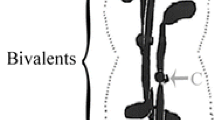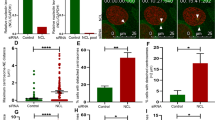Summary
A 69 kDa protein present in the interphase centrosome and mitotic spindle/pole was identified with the CHO2 monoclonal antibodies raised against mitotic spindles isolated from Chinese hamster ovary (CHO) cells. Isolation and characterization of antigen-specific cDNAs and recombinant proteins demonstrated that the protein is a minus-end-directed microtubule motor with the motor domain located at the C terminus. Affinity-purified polyclonal antibodies prepared to bacterially expressed fusion proteins revealed the presence of the antigen in interphase nuclei, and the degree of nuclear immunostaining intensity varied among cells at different cell cycle stages. In order to examine the change of antigen expression during the cell cycle, we prepared synchronized populations of CHO cells, double stained with CHO2 and PCNA (proliferating cell nuclear antigen) antibodies, and quantitated the amounts of nuclear fluorescence using the MetaMorpho image analysis software package. Cells right after cell division contained nuclei with the lowest level of CHO2 immunofluorescence. The immunofluorescence intensity progressively increases through G1 to S, reaching a maximum level by the end of G2. The antibody uniformly stained the entire nuclear region, and the total amount of fluorescence detected in G2 cells was greater than three times that of G1 cells. Cell cycle dependent accumulation of the CHO2 antigen was further confirmed by immunoblot analysis of the protein included in whole cell extracts and nuclei isolated from synchronized CHO cells. Northern blot analysis showed that, although the CHO2-transcript accumulated during later stages of the cell cycle, its abundance declined through G1 to S, and was lowest in cells at the early S phase. The difference in the expression pattern of the antigen protein and its transcript may suggest the presence of multiple mechanisms controlling the level of CHO2 antigen during the course of the cell cycle.
Similar content being viewed by others
References
Ando A, Kikuti YY, Kawata H, Okamoto N, Imai T, Eki T, Yokoyama K, Soeda E, Ikemura T, Abe K, Inoki H (1994) Cloning of a new kinesin-related gene located at the centrometric end of the human MHC region. Immunogenetics 39: 194–200
Brown KD, Coulson RMR, Yen TJ, Cleveland DW (1994) Cyclinlike accumulation and loss of the putative kinetochore motor CENP-E results from coupling continuous synthesis with specific degradation at the end of mitosis. J Cell Biol 125: 1303–1312
Endow SA, Henikoff S, Soler-Niedziela L (1990) Mediation of meiotic and early mitotic chromosome segregation inDrosophila by a protein related to kinesin. Nature 345: 81–83
—, Chandra R, Komma DJ, Yamamoto AH, Salmon ED (1994a) Mutants of theDrosophila ncd microtubule motor protein cause centrosomal and spindle pole defects in mitosis. J Cell Sci 107: 859–867
—, Kang SJ, Satterwhite LL, Rose MD, Skeen VP, Salmon ED (1994b) Yeast Kar3 is a minus-end microtubule motor protein that destabilizes microtubules preferentially at the minus end. EMBO J 13: 2708–2713
Goldstein LSB (1993) With apologies to Scheherazade: tails of 1001 kinesin motors. Annu Rev Genet 27: 319–351
Goodson HV, Kang SJ, Endow SA (1994) Molecular phylogeny of the kinesin family of microtubule motor proteins. J Cell Sci 107: 1875–1884
Hirano T, Mitchison TJ (1994) A heterodimeric coiled-coil protein required for mitotic chromosome condensation in vitro. Cell 79: 449–458
Kuriyama R, Borisy GG (1981) Centriole cycle in Chinese hamster ovary cells as determined by whole mount electron microscopy. J Cell Biol 91: 814–821
—, Keryer G, Borisy GG (1984) The mitotic spindle of Chinese hamster ovary cells isolated in taxol-containing medium. J Cell Sci 66: 265–275
—, Dragas-Granoic S, Maekawa T, Vassilev A, Khodjakov A, Kobayashi H (1994) Heterogeneity and microtubule interaction of the CHO1 antigen, a mitosis-specific kinesin-like protein. Analysis of subdomains expressed in insect Sf9 cells. J Cell Sci 107: 3485–3499
—, Kofron M, Essner R, Kato T, Dragas-Granoic S, Omoto CK, Khodjakov A (1995) Characterization of a minus-end-directed kinesin-like motor protein from cultured mammalian cells. J Cell Biol 129: 1049–1059
Kurki P, Ogata K, Tan EM (1988) Monoclonal antibodies to proliferating cell nuclear antigen (PCNA)/cyclin as probes for proliferating cells by immunofluorescence microscopy and flow cytometry. J Immunol Methods 109: 49–59
McDonald HB, Goldstein LSB (1990) Identification and characterization of a gene encoding a kinesin-like protein inDrosophila. Cell 61: 991–1000
—, Steward RJ, Goldstein LSB (1990) The kinesin-likencd protein ofDrosophila is a minus end-directed microtubule motor. Cell 63: 1159–1165
McIntosh JR, Pfarr CM (1991) Mitotic motors. J Cell Biol 115: 577–585
Meluh PB, Rose MD (1990)KAR3, a kinesin-related gene required for yeast nuclear fusion. Cell 60: 1029–1041
Mitsui H, Yamaguchi-Shinozaki K, Shinozaki K, Nishikawa K, Takahashi H (1993) Identification of a gene family (kat) encoding kinesin-like proteins inArabidopsis thaliana and the characterization of secondary structure of KatA. Mol Gen Genet 238: 362–368
Miyachi K, Fritzler MJ, Tan EM (1978) Autoantibody to a nuclear antigen in proliferating cells. J Immunol 121: 2228–2234
Nislow C, Lombillo VA, Kuriyama R, McIntosh JR (1992) A plusend-directed motor enzyme that moves antiparallel microtubules in vitro localizes to the interzone of mitotic spindles. Nature 359: 543–547
O'Connell MJ, Meluh PB, Rose MD, Morris NR (1993) Suppression of thebimC4 mitotic spindle defect by deletion ofklpA, a gene encoding a KAR3-related kinesin-like protein inAspergillus nidulans. J Cell Biol 120: 153–162
Ogata K, Kurki P, Celis JE, Nakamura RM, Tan EM (1987) Monoclonal antibodies to a nuclear protein (PCNA/cyclin) associated with DNA replication. Exp Cell Res 168: 475–486
Rhoads DD, Roufa DJ (1985) Emetine resistance of Chinese hamster cells: structures of wild-type and mutant ribosomal protein S14 mRNAs. Mol Cell Biol 5: 1665–1669
Roberts B (1989) Nuclear location signals-mediated protein transport. Biochim Biophys Acta 1008: 263–280
Sawin KE, Endow SA (1993) Meiosis, mitosis, and microtubule motors. BioEssays 15: 399–407
Sellitto C, Kuriyama R (1988) Distribution of a matrix component of the midbody during the cell cycle in Chinese hamster ovary cells. J Cell Biol 101: 431–439
—, Kimble M, Kuriyama R (1992) Heterogeneity of microtubule organizing center components as revealed by monoclonal antibodies to mammalian centrosomes and to nucleus-associated bodies fromDictyostelium. Cell Motil Cytoskeleton 22: 7–24
Strunnikov AV, Larionov VL, Koshland D (1993)SMC1: an essential yeast gene encoding a putative head-rod-tail protein is required for nuclear division and defines a new ubiquitous protein family. J Cell Biol 123: 1635–1648
Vale RD, Goldstein LSB (1990) One motor, many tails: an expanding repertoire of force-generating enzymes. Cell 60: 883–885
Walker RA, Salmon ED, Endow SA (1990) TheDrosophila claret segregation protein is a minus-end directed motor molecule. Nature 347: 780–782
Yen TJ, Li G, Schaar BT, Szilak I, Cleveland DW (1992) CENP-E is a putative kinetochore motor that accumulates just before mitosis. Nature 359: 536–539
Author information
Authors and Affiliations
Rights and permissions
About this article
Cite this article
Ohta, T., Kimble, M., Essner, R. et al. Cell cycle-dependent expression of the CHO2 antigen, a minus-end directed kinesin-like motor in mammalian cells. Protoplasma 190, 131–140 (1996). https://doi.org/10.1007/BF01281312
Received:
Accepted:
Issue Date:
DOI: https://doi.org/10.1007/BF01281312




